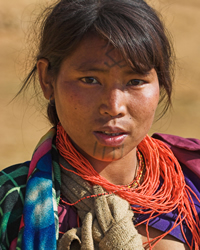The Kuku people use the name Makhaungnyon (“Makhaung people”) for their ethnic group, and Makhaung for their language. Other tribes in the area know them as Voi Khawng, Vuko, Vukii, and Kuku. They are culturally connected to the Tangshang group of tribes in Myanmar, which in turn is a subset of the larger Naga race, which includes over 100 tribes across the mountains of northeast India and Myanmar.
Location: Two thousand members of the Kuku tribe live in Dunghi, which is part of Lahe Township in western Myanmar's Sagaing Region. Their three main villages are Kuku Nokkon (40 households), Ahang Kuku (30), and Myang Kuku (29). In 2012, 693 Kuku people lived in these three villages,1 while others lived in scattered villages with other ethnicities. Kuku territory is located east of the Namphuk River. Although the Kuku live only about 25 miles (40 km) in a straight line from the border with the Indian state of Nagaland, several rugged mountain ranges and deep valleys make it almost impossible to reach by foot.
Language: Although the Kuku are associated with other Tangshang tribes and vernaculars, including Lakki, a linguist has determined that "The Kuku speak a distinct variety of Paungnyuan (Makyam) Naga. We found that they understand and accept standard Paungnyuan well enough that it seems that they could share materials.” The Kuku language shares only a 24% lexical similarity with Shecyu, which is the lowest recorded lexical similarity among almost 50 Tangshang varieties in a 2013 study. However, most Kuku people can also speak Burmese, and “all Kuku individuals reported that they are very interested in reading Paungnyuan literature, and would encourage their children to attend a literacy class if one was available.”
For centuries the Kuku lived in relative isolation in their mountainous hideouts, “following a democratic system that elected their leaders from the best candidates available.” Their isolation was shattered as the Kachin Jingpo grew in power and expanded their influence southward. By the 1920s, “the Jingpo had made significant inroads…and had even established villages as far west as the Namphuk River south of Kuku, from where they dominated local villages, exacting tribute and making demands for labor…. This domination, along with attacks from powerful Naga villages to their west, was one of the factors that led to a significant movement of groups into India during the 19th century.”
The Kuku people were renowned for their burial rituals. Unlike other tribes in the area that practiced platform burials, the Kuku “first smoked the corpse over a slow fire before placing it in a wooden coffin and taking it to a charnel house near the village. At a certain fixed date the skulls were removed from the bodies and washed with hot water and then taken by clan members to a secret area where shelving rock had created ledges. Here they were deposited along with the skulls of previous clan members.”
For centuries the Kuku lived in spiritual darkness, enslaved by the spirit world and making costly annual sacrifices at specially constructed nat (spirit) houses in a bid to appease the demonic world. The light of Jesus Christ gradually dawned over the Kuku people, with hundreds of families converting to Christianity between the 1970s and 1990s. Whereas the neighboring Paungnyuan tribe contains many Buddhists, all Kuku people today are believed to be followers of Christ.
Not only are all Kuku people reportedly Christians today, they all belong to the Baptist denomination.8 Because of the lack of any Scripture in their own language, Kuku believers are forced to use Burmese Bibles. According to a report, however, “All Kuku Christians are interested in having the Bible in the related Paungnyuan language. They want to know God's Word, and they want to be able to read it. They would buy a Bible if it was available, and they would attend literacy classes in their village if a Bible translation was commenced.”
Scripture Prayers for the Kuku in Myanmar (Burma).
| Profile Source: Asia Harvest |











